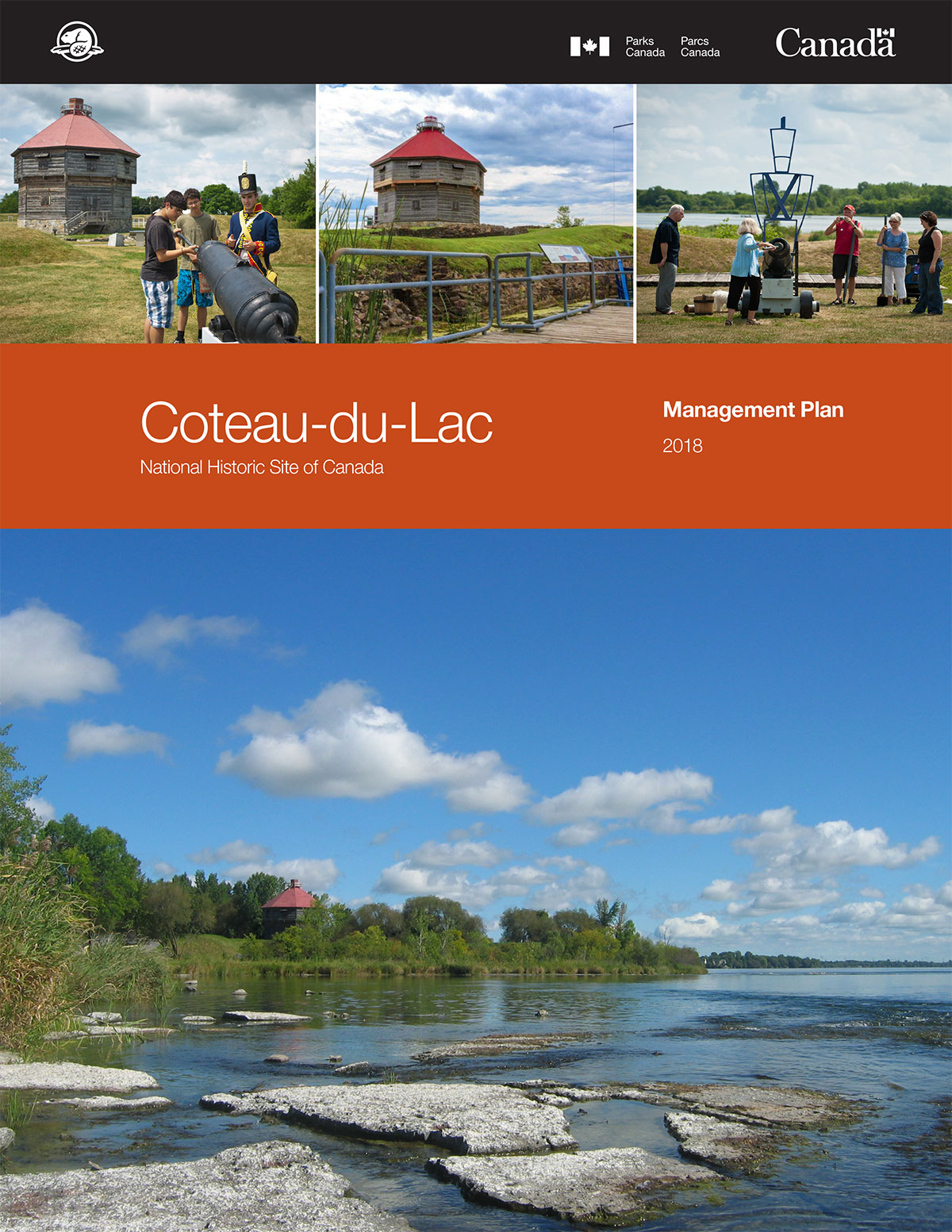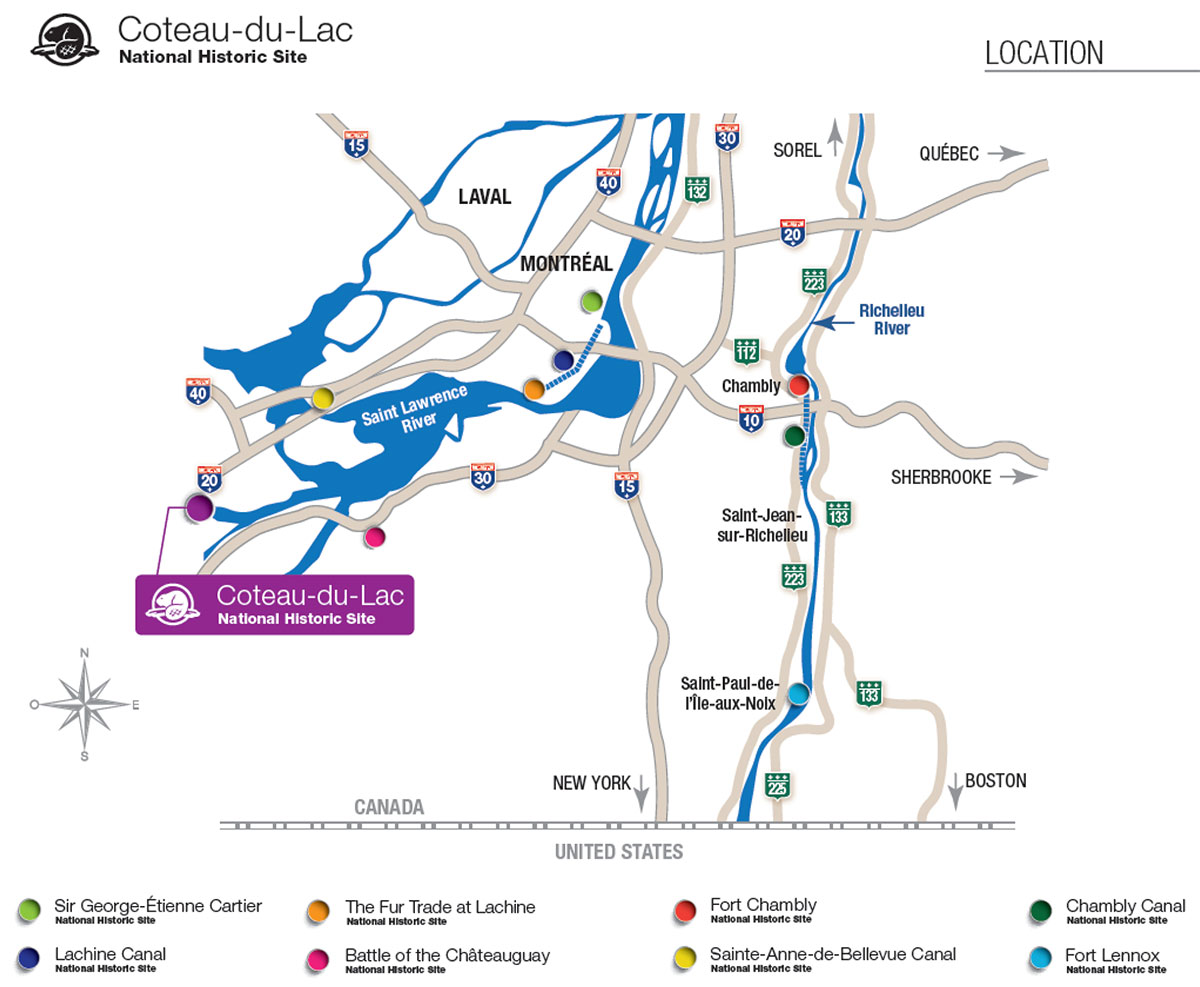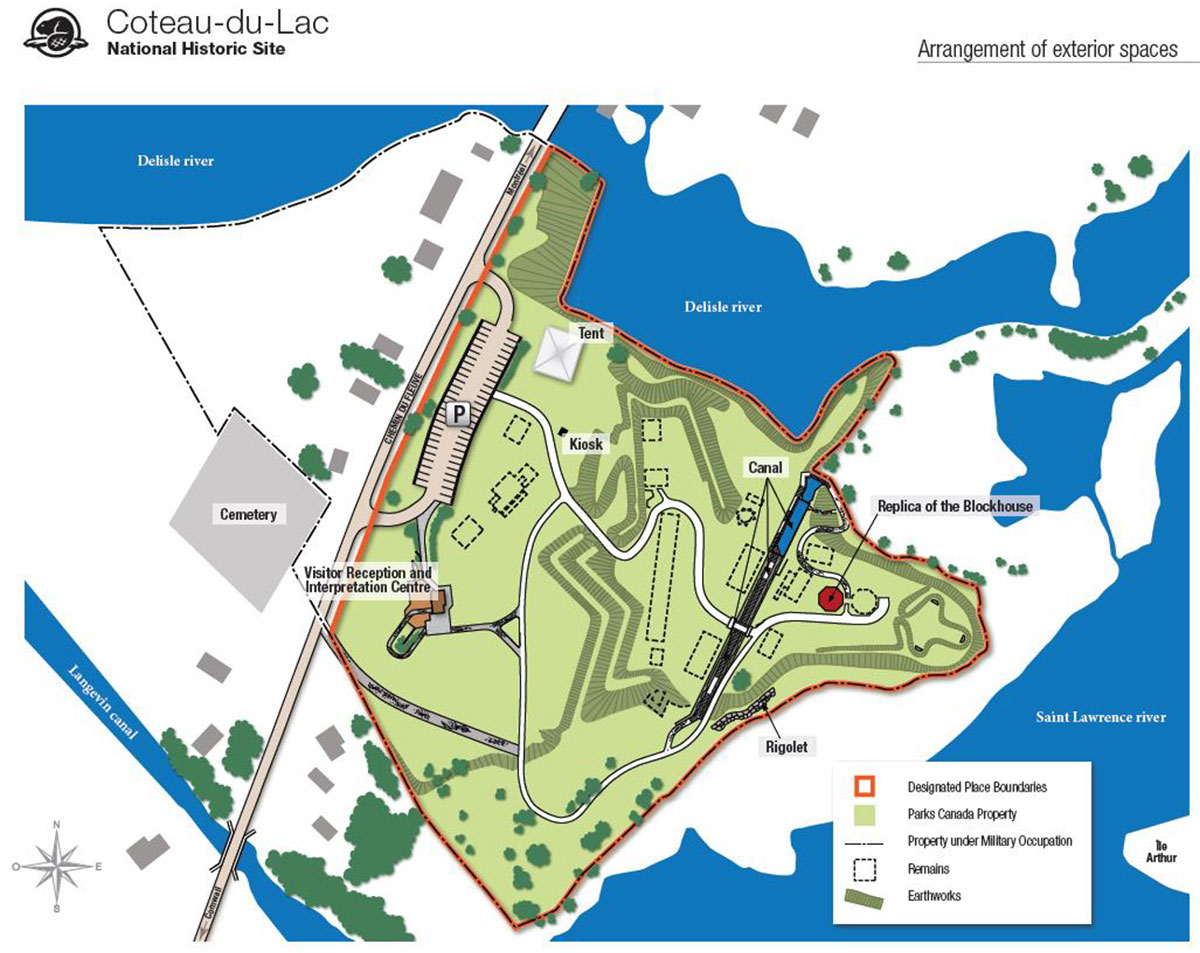Coteau-du-Lac National Historic Site of Canada Management Plan 2018
Coteau-du-Lac National Historic Site
Table of Contents

© Her Majesty the Queen in Right of Canada, represented by the Chief Executive Officer of Parks Canada, 2018.
Cette publication est aussi disponible en français.
Paper:
- R64-105/56-2018E
- 978-0-660-27932-9
- R64-105/56-2018E-PDF
- 978-0-660-27931-2
For more information about the management plan or about Coteau-du-Lac Cartier National Historic Site:
Coteau-du-Lac, Quebec
J0P 1B0
Canada
Front cover image credits
top from left to right: Parks Canada
bottom: Parks Canada
Foreword

Canada’s national parks, national historic sites and national marine conservation areas belong to all Canadians and offer truly Canadian experiences.
These special places make up one of the finest and most extensive systems of protected natural and cultural heritage areas in the world.
The Government is committed to preserving our natural and cultural heritage, expanding the system of protected places and contributing to the recovery of species-at-risk. At the same time, we must continue to offer new and innovative visitor and outreach programs and activities so that more Canadians can experience Parks Canada places and learn about our environment, history and culture.
This new management plan for the Sir George-Étienne Cartier National Historic Site of Canada supports this vision.
Management plans are developed through extensive consultation and input from various people and organizations, including Indigenous peoples, local and regional residents, visitors and the dedicated team at Parks Canada.
National parks, national historic sites and national marine conservation areas are a priority for the Government of Canada. I would like to thank everyone who contributed to this plan for their commitment and spirit of co-operation.
As the Minister responsible for Parks Canada, I applaud this collaborative effort and I am pleased to approve the Coteau-du-Lac National Historic Site of Canada Management Plan.
Original signed by
Recommendations
Approved by and original signed by
Michael Nadler
Acting Chief Executive Officer
Parks Canada
Trevor Swerdfager
Senior Vice-President, Operations
Parks Canada
Nadine Blackburn
Field Unit Superintendent
La Mauricie and Western Quebec Field Unit
Parks Canada
Executive Summary
The Coteau-du-Lac National Historic Site is located at the heart of the municipality of Coteau-du-Lac (Quebec), approximately 40 km southwest of Montreal. The designated place covers an area of 3.09 hectares at the confluence of Delisle River and St. Lawrence River, near the Coteau-du-Lac rapids. Since its opening in 1968, the site, located in delightful surroundings, has allowed the public to discover the remains of military buildings and canals, a reconstructed Blockhouse, as well as exhibitions exploring the site’s different periods of occupation, from the paleohistoric era, when it was used by Indigenous peoples, to the British period, when it served as a military post.
In the present management plan, two key strategies are presented that aim to guide the historic site’s management for the next decade.
Key strategy 1:
Turn the National Historic Site into a vital area of convergence for the community and regional partners.
This strategy emphasizes the site’s various opportunities for collaboration and integration within a regional tourism context. Furthermore, it focuses on increasing opportunities to use the site in alternative ways, such as for events and activities.
The strategy aims to:
- Renew collaborative efforts between stakeholders and partners with the goal of organizing activities and events on site.
- Improve the site’s integration into regional tourism development.
- Diversify target audiences by facilitating alternative ways of using the national historic site.
Key strategy 2:
This strategy aims to raise public awareness of the national historic site’s significance as a heritage centre. Due to the site’s layout, many visitors are unaware of its heritage value and fail to understand its national historical significance.
The strategy aims to:
- Update visitor reception, orientation, and flow.
- Upgrade interpretation services to better convey the site’s importance, particularly its significance for Indigenous people.
- Continue to ensure the protection and development of cultural resources.
1.0 Introduction
Parks Canada manages one of the finest and most extensive systems of protected natural and historic places in the world. The Agency’s mandate is to protect and present these places for the benefit and enjoyment of current and future generations. Future-oriented, strategic management of each national park, national marine conservation area, heritage canal and those national historic sites administered by Parks Canada supports the Agency’s vision:
“Canada’s treasured natural and historic places will be a living legacy, connecting hearts and minds to a stronger, deeper understanding of the very essence of Canada.”
The Parks Canada Agency Act requires Parks Canada to prepare a management plan for national historic sites administered by the Agency. The Coteau-du-Lac National Historic Site of Canada Management Plan, once approved by the Minister responsible for Parks Canada and tabled in Parliament ensures Parks Canada’s accountability to Canadians, outlining how historic site management will achieve measurable results in support of the Agency’s mandate.
Canadians, including Indigenous peoples were involved in the preparation of the management plan, helping to shape the future direction of the national historic site. The plan sets clear, strategic direction for the management and operation of the Coteau-du-Lac National Historic Site by articulating a vision, key strategies and objectives. Parks Canada will report annually on progress toward achieving the plan objectives and will review the plan every ten years or sooner if required.
This plan is not an end in and of itself. Parks Canada will maintain an open dialogue on the implementation of the management plan, to ensure that it remains relevant and meaningful. The plan will serve as the focus for ongoing engagement on the management of the Coteau-du-Lac National Historic Site in years to come.
Map 1: Regional Setting

Regional setting of The Coteau-du-Lac National Historic Site - Text Version
Map showing Parks Canada locations :
- Coteau-du-Lac National Historic Site
- Sir George-Étienne Cartier National Historic Site
- Lachine Canal National Historic Site
- The Fur Trade at Lachine National Historic Site
- Battle of the Châteauguay National Historic Site
- Fort Chambly National Historic Site
- Saint-Anne-de-Bellevue Canal National Historic Site
- Chambly Canal National Historic Site
- Fort Lennox National Historic Site
Map 2: The Coteau-du-Lac National Historic Site

Arrangement of exterior spaces of The Coteau-du-Lac National Historic Site - Text Version
Arrangement of exterior spaces:
- Cemetery
- Visitor Reception and Interpretation Centre
- Tent
- Kiosk
- Canal
- Replica of the Blockhouse
- Rigolet
2.0 Significance of the Coteau-du-Lac National Historic Site
Coteau-du-Lac was designated a national historic site in 1923 for the following reasons:
- It is the site of one of the oldest lock canals in North America.
- From 1778 to the mid-19th century, the place was the site of a British military post which defended the corridor and facilitated the transportation of merchandise on the St. Lawrence River.
- The site was a strategic point during the American Revolution and during the War of 1812.
- The site was for many years the main port of entry of imports into Upper Canada.
Thanks to its strategic location, this area steeped in history has always been an ideal port of entry to the country. Artefacts discovered by Parks Canada archeologists in the 1960s confirmed the presence of First Nations people dating back 7,000 years. The site was subsequently used by French voyageurs and was eventually occupied by the British military, as evidenced by the remains of military buildings, fortifications, a rigolet canal, and the first lock canal in Canada. A British Blockhouse was rebuilt in the 1960s and has marked the cultural landscape.
For local and regional communities, the area is not just a national historic site, but also functions as an urban waterfront park where people can relax and enjoy nature. The grassy terrain is criss-crossed by trails and its periphery is dotted with trees and shrubs. The park is open at all times, even outside of Parks Canada periods of operation.
3.0 Planning Context
The national historic site opened its doors in 1968. To date, conservation and development efforts have been carried out based on two previous management plans, the most recent of which has been in effect since 2007. Most of the management measures set out in the 2007 management plan were implemented, particularly those aiming to improve the visitor experience and the protection and development of cultural resources.
In 2011, a marquee and welcome gateway were installed, and in 2014, the outdoor self-guided tour itinerary was updated.
The site’s commemorative integrity was enhanced thanks to visual improvements, repeated repointing of the ruins, and more recently, major restoration work on the Blockhouse (2016-2017).
Over the past few years, two activities presented in collaboration with the municipality of Coteau-du-Lac have accounted for more than half of the site’s traffic: the “Marché Champêtre” farmer’s market (8,000 visitors) and Canada Day (7,000 visitors). Incidentally, the municipality of Coteau-du-Lac is the national historic site’s main partner. Other activities were organized by third parties, including many sporting events.
Since 2012, the site is available for self-guided experiences from June to September. Groups (mainly day camps) are welcome in July and August and are offered personalized service. Following a 52% drop in visitor numbers between 2012 and 2013 (30,709 to 14,518), these numbers increased by 38% and reached an annual average of 20,000 since 2014.
Several issues were raised during the management plan’s development, such as:
- The difficulty of maintaining visitor numbers at the site: After a significant drop in 2011 and 2012, visitor numbers have increased in the past few years. However, this growth remains fragile.
- The national historic site’s layout does not convey the value of its national historic significance: Visitors sometimes get disoriented and don’t always realize that they are on a national historic site. The visitor circuit does not adequately guide visitors toward the site’s cultural resources, which makes it difficult for them to understand all aspects of its historical significance. The site is open to everyone, even outside of the park’s hours and periods of operation. Its extensive green spaces and proximity to the Delisle and St. Lawrence rivers make it ideal for recreational activities.
- The need to strengthen ties with the Indigenous communities connected to the national historic site: Many traces of paleohistoric occupation confirm the presence of Indigenous peoples at the site before the arrival of Europeans. Parks Canada has initiated a dialogue with several Indigenous communities related to the national historic site. The Agency wishes to strengthen these ties and undertake a joint approach to enhance the presentation and commemoration of the Indigenous culture related to the site.
4.0 Vision
The Coteau-du-Lac National Historic Site is an evocative landscape where history, nature, and cultures come together.
It is an iconic place for residents of Coteau-du-Lac and the Vaudreuil-Soulanges region.
Within the next 15 years, the national historic site will be:
- A welcoming area rooted in its surroundings, where everyone can enjoy a variety of experiences.
- A place where cultural resources are protected, preserved, and highlighted.
- A place with a rich tapestry of history and a diversity of perspectives that are adequately conveyed, recognized, and understood by visitors. This history, which spans more than 7,000 years, includes the successive use of the site by Indigenous peoples, French voyageurs, and the British military.
- A key element of regional tourism thanks to the involvement of regional partners.
5.0 Key Strategies
The strategic focus for the Coteau-du-Lac National Historic Site includes two key strategies and objectives that will allow Canadians to gain a broader understanding and appreciation of the historic site, strengthen the site’s ties with the community, and preserve its heritage resources. Each objective comprises one or more targets to easily measure the management plan’s achievements.
Key strategy 1:
Turn the national historic site into a vital area of convergence for the community and regional partners.
This strategy emphasizes the site’s various possibilities of collaboration and integration within a regional tourism context. Furthermore, it focuses on increasing opportunities to use the site in alternative ways, such as for events and activities. The aim is to strengthen the site’s position as a must-see destination for the Vaudreuil-Soulanges region and the municipality of Coteau-du-Lac, and to consequently draw a wider and more diverse audience.
Objective 1.1:
Renew and expand our collaboration with stakeholders, Indigenous communities, and partners to organize activities and events that align with the site’s vocation.
Target:
The national historic site will host two annual events or visitor experiences organized in collaboration with stakeholders, partners, or Indigenous communities.
Objective 1.2:
Integrate the national historic site into regional tourism development.
Targets:
- Every year, the national historic site will take part in the regional promotional strategy.
- An annual promotional activity or networking event will take place.
Key strategy 2:
Promote the national historic site’s significance as a heritage centre
This strategy aims to raise public awareness of the national historic site’s significance as a heritage centre, either by adapting the site’s traditional activities or encouraging alternative ways of using the place. Due to the site’s layout, many visitors are unaware of its heritage value and fail to understand its historical significance.
Objective 2.1:
Improve visitor reception, orientation, and flow.
Target:
By 2020, the visitor circuit will be updated to improve visitor reception, orientation, and flow.
Objective 2.2:
Improve the public’s understanding of the site’s heritage value and present the diversity of historical perspectives through interpretation services.
Target:
By 2025, the interpretation program will be updated.
Objective 2.3:
Work together with Indigenous communities, linked to the site, in order to honor and showcase their culture and to present their contributions to the site’s history.
Targets:
- By 2020, build a relationship with the Indigenous communities linked to the site.
- By 2025, hold activities or events in collaboration with the Indigenous communities linked to the site.
Objective 2.4:
Continue to ensure the protection of cultural resources.
Target:
The condition of priority cultural resources will remain stable or improve.
6.0 Summary of the Strategic Environmental Assessment
Parks Canada is responsible for assessing and mitigating the impacts of management actions on ecosystems and on cultural resources. The Cabinet Directive on the Environmental Assessment of Policy, Plan and Program Proposals prepared by the Canadian Environmental Assessment Agency, requires a strategic environmental assessment of all plans and policies submitted to the federal Cabinet or to a Minister for approval deemed to have important positive or negative environmental effects.
A strategic environmental assessment was undertaken on this management plan. This assessment has been submitted to participants in the consultations related to the development of this management plan. The concerns raised were taken into account. The following presents the environmental assessment.
The strategies set out in the Coteau-du-Lac National Historic Site management plan will allow Canadians to gain a broader understanding and appreciation of the national historic site, strengthen the site's ties with the community, and preserve its heritage resources. The implementation of measures to achieve the objectives set out in the management plan will help protect the site's cultural resources and improve the commemorative integrity of the Coteau-du-Lac National Historic Site.
Certain strategies, objectives and targets identified in the management plan could eventually have negative environmental effects and require mitigation measures. Specifically, more visitors and increased site usage may result in greater resource usage and waste production, which may in turn impact the site's cultural resources. The strategic environmental assessment also made it possible to identify potential environmental effects on the site's vegetation and riparian strip. However, these potential environmental impacts could be mitigated by following the existing guidelines and carrying out impact assessments for on-site projects such as installations, activities, and new events, as well as cultural resource conservation and maintenance projects. These assessments will determine the effects on the site's value components and help minimize potential negative impacts on the cultural and natural resources, the visitor experience, and the relationships with different partners.
It is impossible to determine whether the management plan will make a significant contribution to the achievement of the Federal Sustainable Development Strategy's goals, but, considering Parks Canada's mandate, it is unlikely that it will hinder their progress. No significant negative environmental impacts are expected following the implementation of the management plan.
- Date modified :